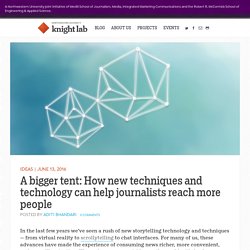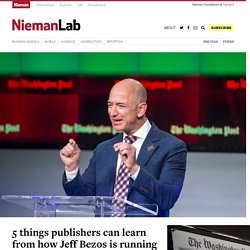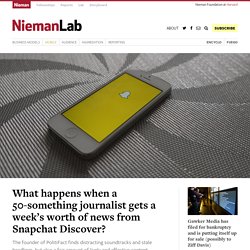

Wbkd/awesome-interactive-journalism: A list of awesome interactive journalism projects. Want to Attract More Readers? Try Listening to Them. Azure-blockchain-projects/bletchley-whitepaper.md at master · Azure/azure-blockchain-projects. State of the News Media 2016. This GIF Shows the Evolution of the Breaking News From Orlando. Times Insider delivers behind-the-scenes insights into how news, features and opinion come together at The New York Times.

Photo When news breaks, editors must decide quickly how much coverage to give it. Is the story important? What are the broader implications? Will the situation get worse? In a digital age, new information comes quickly. Video news isn’t growing as fast as you’d think, and other surprising findings from a new global survey. This week, a Facebook executive suggested that your News Feed is likely to be “all video” in the next five years.

“We’re seeing a year-on-year decline on text. We’re seeing a massive increase, as I’ve said, on both pictures and video,” Nicola Mendelsohn said. “If I was having a bet, I would say: video, video, video.” But a new report out Tuesday from Oxford’s Reuters Institute for the Study of Journalism suggests that text may have a longer run, at least for news. Le CSA se dote d’un laboratoire d’idées sur l’audiovisuel et le numérique : le CSA lab. Communiqué du mardi 14 juin 2016 Lancement du CSA lab, le 14 juin 2016 au CSA.

Olivier Schrameck, président du Conseil supérieur de l’audiovisuel, a lancé ce jour le CSA lab, comité de réflexion prospective coprésidé par Nathalie Sonnac et Nicolas Curien, membres du Conseil. Sept experts composent à leurs côtés ce laboratoire d’idées sur l’audiovisuel et le numérique : Maya Bacache-Beauvallet, Yann Bonnet, Olivier Henrard, Pascale Idoux, Winston Maxwell, Francesca Musiani et Marc Tessier.
Le CSA lab constitue une « instance de réflexion permettant d’examiner les transitions engendrées par la transformation numérique dans le secteur de l’audiovisuel », comme l’a défini Nicolas Curien, président du groupe de travail « Services audiovisuels numériques, distribution, accessibilité et prospective » lors de la conférence de presse de lancement. L’idée est d’accompagner le CSA dans un environnement en perpétuelle évolution où les outils de régulation actuels doivent être évalués et adaptés.
A bigger tent: How new techniques and technology can help journalists reach more people. In the last few years we’ve seen a rush of new storytelling technology and techniques — from virtual reality to scrollytelling to chat interfaces.

For many of us, these advances have made the experience of consuming news richer, more convenient, and more illuminating. We can learn more quickly, see the world with fresher eyes, and immerse ourselves in stories in ways that go far beyond text on a page or moving images. For those of us who create these stories, opportunities abound for us not only to do cool, new things, but also to bring our work to new people. With new storytelling and distribution techniques and technologies we can reach people who otherwise would have had a difficult time finding our work or accessing it because of government censorship, language barriers, limited technical resources, and more. At Knight Lab, we recently began asking ourselves how we can reach new and wider audiences with digital (and sometimes analog) news.
OutOfHoMedia: Ad block this. Publishers can challenge Google and Facebook if they form a network. At the top of the list of frustrations media organisations share is the accelerated pace of advertising revenue slipping through their fingers.

Mary Meeker’s latest internet trends report captures the story brilliantly in a single slide: Strategies for shifting from analog to digital media models seem too little too late already. Google and Facebook are having no problem creating more ways to attract advertisers and more share of spend, over 75% of it, while everyone else is struggling. Sans titre. Les entreprises françaises peinent à tirer profit du numérique... par manque de culture. New stats show how many newspaper jobs the internet has claimed. Between 1990 and 2016, the newspaper publishing industry shrunk by nearly 60 percent, from roughly 458,000 jobs to 183,000 jobs, the bureau found.

In this same time, the number of internet publishing and broadcasting jobs rose from 30,000 to 198,000. In just under three decades, the newspaper industry has transformed from a media juggernaut into a secondary form of communication, and there are no signs this trend will reverse any time soon. Most newspaper organizations have migrated online, including The Washington Post and The New York Times, where they tend to carry over traditional subscription models.
In August 2015, more than four years after launching a digital paywall program, The New York Times announced it had accumulated more than 1 million digital-only subscribers. The Bezos Effect: How Amazon’s Founder Is Reinventing The Washington Post – and What Lessons It Might Hold for the Beleaguered Newspaper Business. A new paper by Dan Kennedy, Joan Shorenstein Fellow (spring 2016) and associate professor in the School of Journalism at Northeastern University, provides insight into The Washington Post’s digital strategy and business model following its acquisition by Amazon founder and CEO Jeff Bezos.

5 things publishers can learn from how Jeff Bezos is running The Washington Post. Editor’s note: Nieman Lab contributor and Northeastern University professor Dan Kennedy has spent the past semester as a Joan Shorenstein Fellow at the Harvard Kennedy School, researching the digital and business strategies of The Washington Post under the ownership of Amazon founder Jeff Bezos.

His paper outlining his findings is available on the Shorenstein Center’s website; here’s an excerpt focusing on what other publishers can learn from Bezos’ leadership. Bob Woodward, the legendary Washington Post reporter who was one-half of the duo that brought down a president, spoke at the First Parish Church in Cambridge last October to promote a new book. The Last of the President’s Men was about Alexander Butterfield, the aide who revealed the existence of the taping system in Richard Nixon’s White House, thus proving that he really was a crook. Toward the end of the evening, a member of the audience asked Woodward how the media business had changed over the years. What happens when a 50-something journalist gets a week’s worth of news from Snapchat Discover? Snapchat wants to be a news source, so I spent the last week on a Snapchat-only diet.

I gave up my breakfast routine of The New York Times, The Washington Post, and the Politico Playbook and tried to survive on the light snacks from the app’s Discover providers. In the words of the cliché-loving journalists who write for Snapchat’s content partners, the results may surprise you! Selling subscriptions through Apple is getting better for publishers — but also for everyone else. Monday is Apple’s big day for software announcements at its annual WWDC conference, but we got an early peek at one of them at The Verge and Daring Fireball today — and it’s one that’ll be of interest to publishers.

The Verge’s Lauren Goode: In a rare pre-WWDC sit-down interview with the The Verge, Phil Schiller, Apple’s senior vice president of worldwide marketing, said that Apple would soon alter its revenue-sharing model for apps. While the well-known 70/30 split will remain, developers who are able to maintain a subscription with a customer longer than a year will see Apple’s cut drop down to 15 percent. Robot Art Raises Questions about Human Creativity. In July 2013, an up-and-coming artist had an exhibition at the Galerie Oberkampf in Paris. It lasted for a week, was attended by the public, received press coverage, and featured works produced over a number of years, including some created on the spot in the gallery.
Altogether, it was a fairly typical art-world event. The only unusual feature was that the artist in question was a computer program known as “The Painting Fool.” Even that was not such a novelty. Art made with the aid of artificial intelligence has been with us for a surprisingly long time. One month in: What CNN has learned from Facebook Messenger bots. CNN has high hopes for Facebook Messenger bots. “Our vision is to be the worldwide leader in mobile and video news storytelling. Messaging apps are in many ways as important a growth platform as mobile has been,” said CNN svp and chief product officer Alex Wellen. Facebook opened its Messenger platform last month, letting any business create chatbots to interact with the 900 million users on the app. Advertisement. The Bot Power List 2016 — How We Get To Next. Science fiction is full of bots that hurt people. HAL 9000 kills one astronaut and tries to kill another in 2001: A Space Odyssey; Ava in Ex Machina expertly manipulates the humans she meets to try and escape her cell; the T-800 is known as The Terminator for obvious reasons.
Even more common, though, are those bots clever and sentient enough to have real personality but undone through their naïveté — from Johnny Five in Short Circuit to the robotic cop in RoboCop, sci-fi is great at examining the dangers of greater intelligence when it’s open to manipulation or lacking concrete moral direction. A smarter bot, a more powerful bot, is also a bot that has more power to do evil things, and in the process expose human hubris. These are all fictional examples, of course, but since we’re starting to see the tech industry shift its focus toward conversational bots as the future of, well, everything, maybe it offers us a useful way to define the power that a bot has. 25. Facebook’s new DeepText AI categorizes everything you write. Quora. Google's Eric Schmidt attacks Europe's universities, tax polices, regulatory environment. Les 4 piliers de la transformation numérique - LK Conseil. Les 4 piliers de la transformation numérique.
Why Video is Changing Everything for Traditional Media. Facebook's director of product design on why websites may be a dying business. 2016 Internet Trends. Kleiner Perkins partners with the brightest entrepreneurs to turn disruptive ideas into world-changing businesses. The firm has helped build and accelerate growth at pioneering companies like AppDynamics, Google, Amazon, Flexus Biosciences, Nest, Waze, Twitter, JD.com and Square. Kleiner Perkins offers entrepreneurs years of operating experience, puts them at the center of an influential network, and accelerates their companies from success to significance. Fusion will now emoji the news using Facebook Messenger. Fusion readers have plenty of options when it comes to reading or watching the publication’s stories.
Amazon puts Alexa in the browser with Echosim.io. Microsoft Garage Introduces News Pro 2.0 with New Bot Called Rowe. Robots have been about to take all the jobs for more than 200 years — Timeline. Peter Thiel, Tech Billionaire, Reveals Secret War With Gawker. Tech Titans Raise Their Guard, Pushing Back Against News Media. These Are The Biggest Skills That New Graduates Lack. Digital media layoffs continue, this time at VICE News – Poynter.
New Media Shares Old Media's Roof - Bloomberg Gadfly. The New York Times of the future is beginning to take shape – Poynter. New York Times Co. to Offer Buyouts to Employees. Washington Post targets Europe. Technology is changing how we live, but it needs to change how we work. Sans titre. A Big Shift Is Coming, and It Could Uber-ize Entire Industries. The Washington Post built a social network for its freelancers to better match skills to stories. Google met le paquet sur l’IA et rattrape son retard en VR. How the New York Times plans to conquer the world. Cover story: Does the front page of a magazine still matter? Vice's Shane Smith: 'Expect a bloodbath' in media within the next year. It’s 2016 and TV Execs Have Decided They Need a Digital Strategy.
Soon We Won’t Program Computers. We’ll Train Them Like Dogs. BuzzFeed's Facebook Live Interview With President Obama Suffers a Bad Streaming Failure. Spaces. Google met le paquet sur l’IA et rattrape son retard en VR. Google Mobile Friendly (2016) est désormais déployé ! Sans titre. Externalisation comptable, la digitalisation pour le meilleur. Expertise comptable : la menace d'uberisation et de robotisation. Vers l'automatisation du métier de comptable. L'exploitation des données au centre des tendances technologiques pour Deloitte - ZDNet. Introduction à la ville numérique avec Philippe Gargov - URBIS le mag. Spotify Pushes Further Into Video With Original Slate of Shows.
Mobile-First News: How People Use Smartphones to Access Information. Apple R&D Reveals a Pivot Is Coming. 5 exemples de stratégie "mobile first" en rédaction. Daily Mail Is Now Posting 650 Videos a Day and Getting 383 Million Monthly Views. Primitive Quantum Computers Are Already Outperforming Current Machines. Qu'est ce qu'on fait ? Recode. WhatsApp launches desktop app. One month in: Four things The New York Times has learned using Facebook Live. In ad-blocking wars, publishers propose a détente – Poynter. From bingo games to brackets, The Washington Post is building “alternative story forms” From bingo games to brackets, The Washington Post is building “alternative story forms”
Google’s new media apocalypse: How the search giant wants to accelerate the end of the age of websites. Google’s new media apocalypse: How the search giant wants to accelerate the end of the age of websites. Google’s new media apocalypse: How the search giant wants to accelerate the end of the age of websites. Talkshow is texting in public. — Talkshow. Group'Union - Coworking Marseille. Platform Cooperativism vs. the Sharing Economy. Gig Economy : le véritable défi des plateformes – Christophe Benavent. The Struggle for Innovation at The New York Times + Subtraction.com.
Sans titre. How Bloomberg's 20-person graphics team visualizes the news. Why are so many world leaders using emojis? Investigating the algorithms that govern our lives. Bots, explained: What is a bot, who’s making them, and why. BuzzFeed Slashes Revenue Forecast: Is This the Beginning of the End of the Millennial Media Bubble? The Digital Media Bloodbath: Hundreds Of Jobs Lost. BuzzFeed slashes forecasts after missing 2015 targets. Here are the important announcements for publishers at Facebook’s F8 keynote.
Bots, the next frontier. Want to start a small data journalism team in your newsroom? Here are 8 steps. Boston Globe editor announces initiative to reinvent newspaper – Poynter. What I Learned from Trying to Innovate at the New York Times. Prevention Magazine Takes Radical Step: No Print Ads. Can news publishers take on the tech giants at their own game? Why mobile designers must focus on creating 'micro-moments' Larry Summers: Data collection is the ultimate public good. Bots, the next frontier. Corporate Media Gatekeepers Protect Western 1% From Panama Leak - Craig Murray. Official Site - the UK's number one best-selling news and current affairs magazine, edited by Ian Hislop.